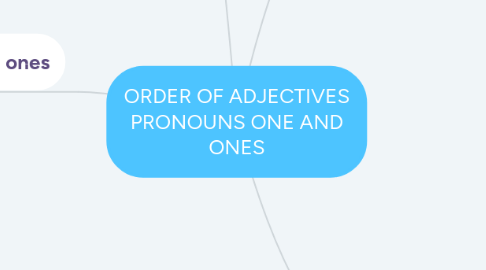
1. PRONOUNS ONE AND ONES
1.1. To avoid repeating yourself, you can use ONE when you are talking about a singular countable noun or ONES when you are talking about a plural countable noun. But it has to be clear from the situation what you are talking about.
1.1.1. Examples
1.1.1.1. I asked for a glass, but they did not have one.
1.1.1.2. I broke my glasses so I will have to buy some new ones.
1.1.1.3. I like those shoes, but let's buy these ones.
2. We use one and ones
2.1. After an adjective
2.1.1. See those two girls? Helen is the tall one and Jane is the short one.
2.1.2. Which is your car, the red one or the blue one?
2.1.3. My trousers are torn. I need some new ones.
2.2. After the
2.2.1. See those two girls? Helen is the one on the left.
2.2.2. Let's look at the photographs – the ones you took in Paris.
2.3. After which in questions
2.3.1. You can borrow a book. Which one do you want?
2.3.2. Which ones are yours?
2.3.3. Examples
2.3.3.1. If you buy beers bottles of beer, you get a third ones free.
2.3.3.2. This bag is very old. I need a new one.
2.3.3.3. Jack has three pens – a red ones and two green ones.
3. ORDER OF ADJECTIVES
3.1. In English, it is common to use more than one adjective before a noun.
3.1.1. For example,
3.1.1.1. , “It is a beautiful long new dress.”, “It is a beautiful long new dress.”, “It is a beautiful long new dress.”
4. When you use more than one adjective, you have to put them in the right order.
4.1. Order of adjectives.
4.1.1. DETERMINER
4.1.1.1. Words that work as articles and other limiters including numbers
4.1.1.1.1. Examples
4.1.2. OPINION
4.1.2.1. In general, an opinion adjective explains what you think about something (other people may not agree with you).
4.1.2.1.1. Examples
4.1.3. SIZE
4.1.3.1. Adjectives that describe a factual or objective quality of the noun.
4.1.3.2. A size adjective, of course, tells you how big or small something is.
4.1.3.2.1. Examples
4.1.4. SHAPE
4.1.4.1. A shape adjective describes the shape of something.
4.1.4.1.1. Examples
4.1.5. AGE
4.1.5.1. An age adjective (adjective denoting age) tells you how young or old something or someone is.
4.1.5.1.1. Examples
4.1.6. COLOR
4.1.6.1. A color adjective (adjective denoting color), of course, describes the color of something.
4.1.6.1.1. Examples
4.1.7. ORIGIN
4.1.7.1. Denominal adjectives denoting source of noun.
4.1.7.2. An origin adjective describes where something comes from.
4.1.7.2.1. Examples
4.1.8. MATERIAL
4.1.8.1. Denominal adjectives denoting what something is made of.
4.1.8.1.1. Examples
4.1.9. PURPOSE
4.1.9.1. Final limiter, often regarded as part of the noun.
4.1.9.2. A purpose adjective describes what something is used for. These adjectives often end with “-ing”.
4.1.9.2.1. Examples

